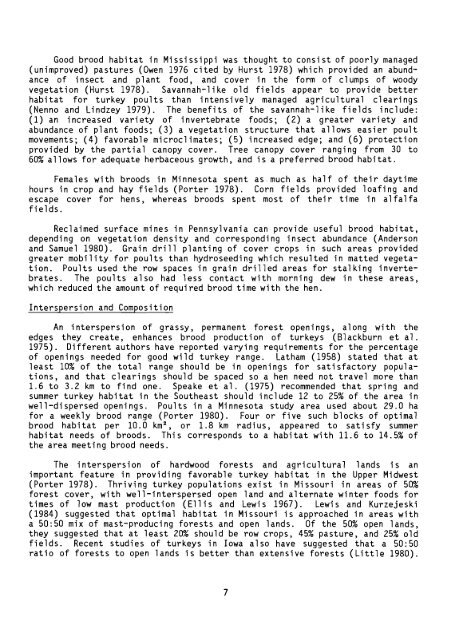habitat suitability index models: eastern wild turkey - USGS National ...
habitat suitability index models: eastern wild turkey - USGS National ...
habitat suitability index models: eastern wild turkey - USGS National ...
You also want an ePaper? Increase the reach of your titles
YUMPU automatically turns print PDFs into web optimized ePapers that Google loves.
Good brood <strong>habitat</strong> in Mississippi was thought to consist of poorly managed<br />
(unimproved) pastures (Owen 1976 cited by Hurst 1978) which provided an abundance<br />
of insect and plant food, and cover in the form of clumps of woody<br />
vegetation (Hurst 1978). Savannah-like old fields appear to provide better<br />
<strong>habitat</strong> for <strong>turkey</strong> poults than intensively managed agricultural clearings<br />
(Nenno and Lindzey 1979). The benefits of the savannah-like fields include:<br />
(1) an increased vari ety of invertebrate foods; (2) a greater vari ety and<br />
abundance of plant foods; (3) a vegetation structure that allows easier poult<br />
movements; (4) favorable microclimates; (5) increased edge; and (6) protection<br />
provided by the partial canopy cover. Tree canopy cover ranging from 30 to<br />
60% allows for adequate herbaceous growth, and is a preferred brood <strong>habitat</strong>.<br />
Females with broods in Minnesota spent as much as half of their daytime<br />
hours in crop and hay fields (Porter 1978). Corn fields provided loafing and<br />
escape cover for hens, whereas broods spent most of their time in alfalfa<br />
fields.<br />
Reclaimed surface mines in Pennsylvania can provide useful brood <strong>habitat</strong>,<br />
depending on vegetation density and corresponding insect abundance (Anderson<br />
and Samuel 1980). Grain drill planting of cover crops in such areas provided<br />
greater mobility for poults than hydroseeding which resulted in matted vegetation.<br />
Poults used the row spaces in grain drilled areas for stalking invertebrates.<br />
The poults also had less contact with morning dew in these areas,<br />
which reduced the amount of required brood time with the hen.<br />
Interspersion and Composition<br />
An interspersion of grassy, permanent forest openings, along with the<br />
edges they create, enhances brood production of <strong>turkey</strong>s (81 ackburn et a1.<br />
1975). Different authors have reported varying requirements for the percentage<br />
of openings needed for good <strong>wild</strong> <strong>turkey</strong> range. Latham (1958) stated that at<br />
least 10% of the total range should be in openings for satisfactory populations,<br />
and that clearings should be spaced so a hen need not travel more than<br />
1.6 to 3.2 km to find one. Speake et al. (1975) recommended that spring and<br />
summer <strong>turkey</strong> <strong>habitat</strong> in the Southeast should include 12 to 25% of the area in<br />
well-di spersed openi ngs. Poults ina Mi nnesota study area used about 29.0 ha<br />
for a weekly brood range (Porter 1980). Four or five such blocks of optimal<br />
brood <strong>habitat</strong> per 10.0 km", or 1.8 km radius, appeared to satisfy summer<br />
<strong>habitat</strong> needs of broods. This corresponds to a <strong>habitat</strong> with 11.6 to 14.5% of<br />
the area meeting brood needs.<br />
The interspersion of hardwood forests and agricultural lands is an<br />
important feature in providing favorable <strong>turkey</strong> <strong>habitat</strong> in the Upper Midwest<br />
(Porter 1978). Thriving <strong>turkey</strong> populations exist in Missouri in areas of 50%<br />
forest cover, with well-interspersed open land and alternate winter foods for<br />
times of low mast production (Ellis and Lewis 1967). Lewis and Kurzejeski<br />
(1984) suggested that optimal <strong>habitat</strong> in Missouri is approached in areas with<br />
a 50:50 mix of mast-producing forests and open lands. Of the 50% open lands,<br />
they suggested that at least 20% should be row crops, 45% pasture, and 25% old<br />
fields. Recent studies of <strong>turkey</strong>s in Iowa also have suggested that a 50:50<br />
ratio of forests to open lands is better than extensive forests (Little 1980).<br />
7

















